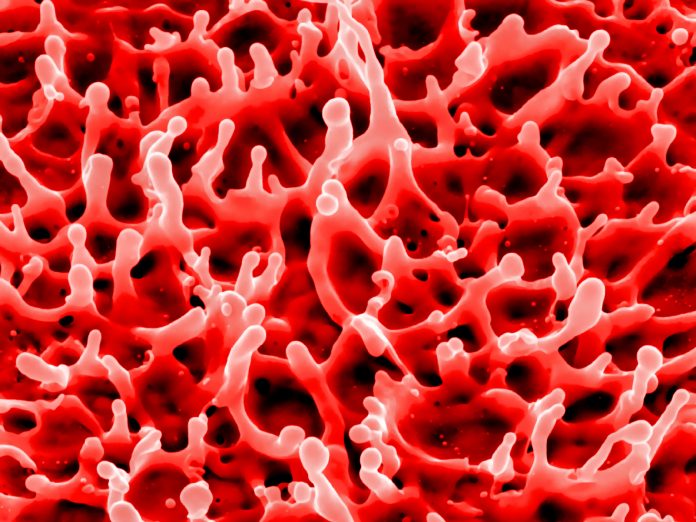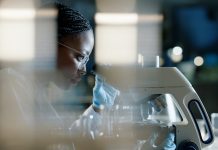Cecilia Van Cauwenberghe from Frost & Sullivan’s TechVision Group, provides further insights about nanomaterials, focussing here on the laser ablation in liquid environment (LALE) technique
The synthesis of chemically clean and environmentally friendly nanoparticles has dramatically evolved since the implementation of laser ablation in liquid environment (LALE) technique and it is presently applied in both laboratory investigations and industrial operations (Shih et al., 2018). It is remarkable, however, that the main foundations of the underlying processes leading to the nanoparticle generation using this technique still remain uncertain. Shih et al. (2018) investigated the bimodal nanoparticle size distributions in femto- and picosecond laser ablation in liquids. According to the authors, such bimodal effect relates small nanoparticles of less than ten nanometres and a narrow size distribution coexisting with large nanoparticles of hundreds of nanometers. The phenomenon is directly associated with the dynamic interaction between the ablation plume and the liquid environment. Whereas large nanoparticles are generated through a sequence of hydrodynamic instabilities at the plume-liquid interface, small nanoparticles are simultaneously nucleated across an expanding metal-liquid mixing region.
Controlling the size and strength of colloidal nanoparticles
In addressing this concern, Choudhury et al. (2018) proposed an effective method for controlling the size distributions of metallic nanoparticles produced through LALE technique that consists of the implementation of physical boundaries in the vicinity of the ablation site. The authors used an Nd:YAG laser of 1064 nm, FWHM 6 ns, to ablate a copper target and a gold target immersed in two different liquid media exhibiting distinctive density and optical properties, water and isopropyl alcohol. According to the researchers, the implemented boundaries have led to notable differences in the size distributions in both liquid media, attributable to the role of the shock wave reflection from the physical boundaries on plasma parameters, hence prolonging the thermal effect of the plasma plume over time, while promoting particle growth in confined geometry. Other authors including Nasria et al. (2019), performed similar experiments using ethanol, hence demonstrating the impact of the fluid environment on controlling the size and strength of colloidal nanoparticles.
Investigations carried out by Saraeva et al. (2019) using of time-resolved emission spectroscopy in the non-filamentation regime concluded that multi-shot ablation in liquids leads to the lesser extent of the processed surface oxidation in comparison with dry environments. According to the authors, this feature makes LALE technique very attractive in surface-enhanced spectroscopes and biomedical devices, biosensors, antibacterial coatings and phototherapies. Similar studies using scanning electron microscopy characterisation of crater topographies and time-resolved optical emission spectroscopy of ablative plumes in regimes were carried out by Kudryashov et al. (2018), who demonstrated that single-shot IR femtosecond-laser ablation of gold surfaces in ambient air and liquid isopropyl alcohol.
Potential applications of LALE technique
Smart nanomaterials leading research trending
A study performed by Tripathy et al. (2017) shows the advantages of killing bacteria physically though nanostructures rather than chemical means. In fact, during the past five years, the use of antimicrobial surfaces has focused on different types of antimicrobial coatings to prevent infections has become very trending, which have led to innovative developments as smart nanomaterials. Overall, nanoparticle dispersions and nanostructured surfaces are practically omnipresent in modern formulations and technological applications for both controlled adhesion and friction in order to improve performance and functionality.
According to Kraushik (2019), such advancements in nanoscience and nanotechnology, typically associated with surface-functionalised nano-systems constitute a fundamental aspect of signal amplification and processing, hence facilitating the development of more sensitive biosensors to be used to detect a targeted biomarker at very low concentrations of femto- or picomolar, for instance. According to the Kraushik, such bionanotech-based sensing strategies provide the principal inputs to optimise an effective therapy in a timely manner and became indispensable to understand epidemic variabilities and develop new therapeutics. The nano-enabled smart surface-functionalised structure adopted for sensing system development, potential biomarkers and interface of bio-active nanostructures need to be clearly understood.
Final remarks
Pulsed laser ablation in liquid environment (LALE) technique has exhibited a variety of advantages over conventional chemical synthesis methods. Nevertheless, the full exploitation of the potential of pulsed laser ablation in liquids for the generation of nanoparticles exhibiting a well-controlled structure, composition and size distribution, demands a deeper understanding of the laser-induced processes responsible for the generation of colloidal nanoparticles. The simultaneous progress in time-resolved experimental research, along with advances in theoretical descriptions and the concomitant optimisation of new computational models of laser-induced processes are critically required.
Acknowledgements
I would like to thank all contributors from the industry involved with the development and delivery of this article from Frost & Sullivan.
References
Choudhury, K., Singh, R.K., Kumar, P., Ranjan, M., Srivastava, A. and Kumar, A., 2019. Effect of confined geometry on the size distribution of nanoparticles produced by laser ablation in liquid medium. Nano-Struc- tures & Nano-Objects, 17, pp.129-137.
Kaushik, A., 2019. Advances in Nanosensors for Biological and Environ- mental Analysis: Book Review. Akash Deep, Sandeep Kumar (Eds.); Elsevier 2019; ISBN: 978-0-12-817456-2.
Kudryashov, S.I., Saraeva, I.N., Lednev, V.N., Pershin, S.M., Rudenko, A.A. and Ionin, A.A., 2018. Single-shot femtosecond laser ablation of gold surface in air and isopropyl alcohol. Applied Physics Letters, 112(20), p.203101.
Nasria, A.H.A., Thahab, S.M. and Hussain, S., 2019. Synthesized and Characterizing of (Au@ Pt) Ultra Fine Nanoparticles Prepared by Pulsed Laser Ablation in Liquids. Journal of Kufa-physics, 11(01), pp.13-18.
Saraeva, I.N., Kudryashov, S.I., Lednev, V.N., Makarov, S.V., Pershin, S.M., Rudenko, A.A., Zayarny, D.A. and Ionin, A.A., 2019. Single-and multishot femtosecond laser ablation of silicon and silver in air and liquid envi- ronments: Plume dynamics and surface modification. Applied Surface Science, 476, pp.576-586.
Shih, C.Y., Streubel, R., Heberle, J., Letzel, A., Shugaev, M.V., Wu, C., Schmidt, M., Gökce, B., Barcikowski, S. and Zhigilei, L.V., 2018. Two mechanisms of nanoparticle generation in picosecond laser ablation in liquids: The origin of the bimodal size distribution. Nanoscale, 10(15), pp.6900-6910.
Tripathy, A., Sen, P., Su, B. and Briscoe, W.H., 2017. Natural and bioinspired nanostructured bactericidal surfaces. Advances in colloid and interface science, 248, pp.85-104.











